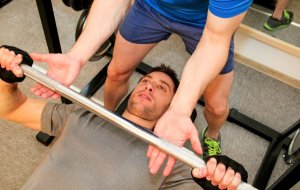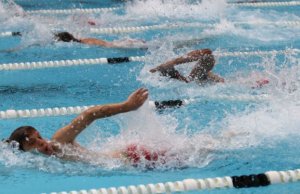Exercises That Can't Be Missing From Your Chest Workout

A chest workout is a required routine for men during training. It’s one of the areas where men place more attention and effort since it’s also one of the most visible areas. Beyond that, the pectoral muscles are one of the largest and most powerful muscle groups in your body.
You need a lot of perseverance and effort to work out this area. That’s why there are plenty of exercises you can do. However, there are certain exercises that are more effective than others in building muscle and increasing the volume of your chest.
It’s also important to keep in mind that there are several areas to work out: among them, we can name the mid, upper and lower chest. Next up, we’ll look at some exercises that can’t be missing from your chest workout.
The best exercises in a chest workout
Bench press: the exercise that can never be missing
Bench pressing is one of the classics and is the most complete exercise in chest training. It has several modalities, depending on the area you want to work. With this exercise, you can define and strengthen this group of muscles through weightlifting.
With the horizontal bench press, you perform the work on a bench horizontally, facing up and with your back against the bench. It’s about lifting a free weight, starting from the chest and raising the arms a few times.
The weight and the number of repetitions vary according to the physical condition, level of training and needs of each person. This exercise helps you work the mid-chest area.
On the other hand, the inclined chest press is the same exercise, but with the difference that the bench will be slightly inclined upwards. In this position, you’ll be strengthening your upper chest.
The third variant of the bench press is the one with the bench inclined downwards or decline chest press. This works the lower part of your chest.

Dumbbell fly
Dumbbell fly is another of the most popular exercises for chest workouts. In this case, you’ll also need a bench, on which you’ll be lying on your back and using dumbbells. The start position will be with your arms stretched towards the front and slightly flexed at the elbows.
From this position, the exercise will consist of opening your arms to the sides until they’re extended, at chest height. Then, return to the initial position by contracting the pectoral muscles. By making this move, you’re working the central area of your chest.
But, be careful not to open your arms too wide, to avoid the work going to your shoulders and not your chest. If this happens, the risk of injury will increase, and you won’t achieve the results you’re looking for.
Chest push-ups
Chest push-ups can’t be missing in your chest workout either. It’s a simple exercise that doesn’t require any particular equipment and it’s very effective. To do this, it’s necessary to lay (face down), with your hands on the floor, at chest height.
Using your feet as the second point of support, try to lift your entire weight until your arms are completely extended. The advantage of this exercise is that, unlike working with weights, it allows you to work the pectorals without forcing your upper back.
You can do this in different positions, depending on the specific area of your chest you want to work on. In addition, doing chest push-ups also strengthens the triceps, abdomen, and glutes.
Swimming
Swimming is an excellent aerobic exercise that helps burn calories and increase your metabolism. It’s also an excellent option for those who want to lose fat or avoid accumulating it. Besides that, swimming works intensely on your chest.

To strengthen and define this area of your body, you must swim mainly with the crawl technique. We recommend you complete short and fast sets if you want to gain volume. However, it’s best to do slower and softer sets if you’re looking to burn fat.
Swimming will also help prevent the aches and pains that can occur with weight-lifting exercises. In fact, it’s one of the most complete sports and activities.
As you may have noticed, the alternatives are really varied when it comes to working your chest. It’s up to each athlete and those who advise them to choose the most appropriate training and know how to regulate it.
In any case, it’s always advisable to warm up before you exercise and stretch when you finish.
A chest workout is a required routine for men during training. It’s one of the areas where men place more attention and effort since it’s also one of the most visible areas. Beyond that, the pectoral muscles are one of the largest and most powerful muscle groups in your body.
You need a lot of perseverance and effort to work out this area. That’s why there are plenty of exercises you can do. However, there are certain exercises that are more effective than others in building muscle and increasing the volume of your chest.
It’s also important to keep in mind that there are several areas to work out: among them, we can name the mid, upper and lower chest. Next up, we’ll look at some exercises that can’t be missing from your chest workout.
The best exercises in a chest workout
Bench press: the exercise that can never be missing
Bench pressing is one of the classics and is the most complete exercise in chest training. It has several modalities, depending on the area you want to work. With this exercise, you can define and strengthen this group of muscles through weightlifting.
With the horizontal bench press, you perform the work on a bench horizontally, facing up and with your back against the bench. It’s about lifting a free weight, starting from the chest and raising the arms a few times.
The weight and the number of repetitions vary according to the physical condition, level of training and needs of each person. This exercise helps you work the mid-chest area.
On the other hand, the inclined chest press is the same exercise, but with the difference that the bench will be slightly inclined upwards. In this position, you’ll be strengthening your upper chest.
The third variant of the bench press is the one with the bench inclined downwards or decline chest press. This works the lower part of your chest.

Dumbbell fly
Dumbbell fly is another of the most popular exercises for chest workouts. In this case, you’ll also need a bench, on which you’ll be lying on your back and using dumbbells. The start position will be with your arms stretched towards the front and slightly flexed at the elbows.
From this position, the exercise will consist of opening your arms to the sides until they’re extended, at chest height. Then, return to the initial position by contracting the pectoral muscles. By making this move, you’re working the central area of your chest.
But, be careful not to open your arms too wide, to avoid the work going to your shoulders and not your chest. If this happens, the risk of injury will increase, and you won’t achieve the results you’re looking for.
Chest push-ups
Chest push-ups can’t be missing in your chest workout either. It’s a simple exercise that doesn’t require any particular equipment and it’s very effective. To do this, it’s necessary to lay (face down), with your hands on the floor, at chest height.
Using your feet as the second point of support, try to lift your entire weight until your arms are completely extended. The advantage of this exercise is that, unlike working with weights, it allows you to work the pectorals without forcing your upper back.
You can do this in different positions, depending on the specific area of your chest you want to work on. In addition, doing chest push-ups also strengthens the triceps, abdomen, and glutes.
Swimming
Swimming is an excellent aerobic exercise that helps burn calories and increase your metabolism. It’s also an excellent option for those who want to lose fat or avoid accumulating it. Besides that, swimming works intensely on your chest.

To strengthen and define this area of your body, you must swim mainly with the crawl technique. We recommend you complete short and fast sets if you want to gain volume. However, it’s best to do slower and softer sets if you’re looking to burn fat.
Swimming will also help prevent the aches and pains that can occur with weight-lifting exercises. In fact, it’s one of the most complete sports and activities.
As you may have noticed, the alternatives are really varied when it comes to working your chest. It’s up to each athlete and those who advise them to choose the most appropriate training and know how to regulate it.
In any case, it’s always advisable to warm up before you exercise and stretch when you finish.
This text is provided for informational purposes only and does not replace consultation with a professional. If in doubt, consult your specialist.








